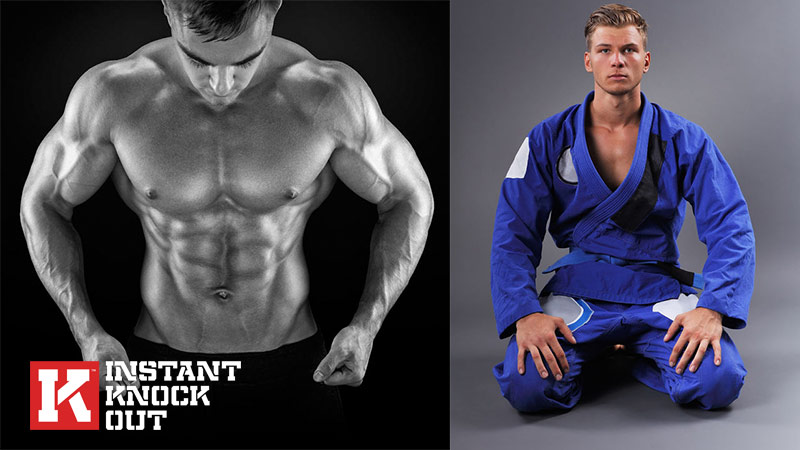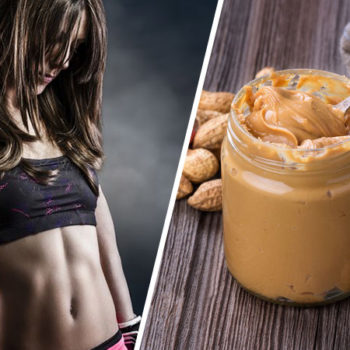BJJ Weight Loss Plan – Getting Shredded with Martial Arts

The top BJJ stars are ripped, lean and absolutely shredded. Every athlete looks to enter the arena with a body resembling a statue masterfully cut from stone. Learn how you too can earn such an impressive physique, with this free BJJ weight loss plan.
In fight sports, there is no space for useless excess body fat. As every athlete steps onto the scales at the weigh-in, lean muscle mass must be at an all-time high. Every pound matters and fat does nothing in the way of function.
Elite level Brazilian Jiu-Jitsu competitors proudly promote a clean lifestyle. When training hard for a tournament they won’t be found drinking in the bar or feasting on fast food. They’re on the mats every single day, torching through fat and maximizing recovery with nutritious healthy foods.
It’s this perfect combination of calorie-crushing exercise and optimized dieting that shapes their bodies. But rippling abs and super defined biceps aren’t just reserved for the world champions. In fact, many amateurs and weekend warriors look this way, and here’s why…
What makes BJJ so effective?
Brazilian Jiu Jitsu, BJJ for short, has quite literally exploded across almost every continent on earth. What was once a niche fighting style developed by the Gracies in Brazil is now a global sensation, with academies found in every city.
Over 25 years ago the world was first exposed to the power of BJJ. Rorion Gracie, a member of the founding family, devised a plan to showcase the art in a ruthless no holds barred event. Thus, the UFC was born.
Today electrifying Ultimate Fighting Championship events are broadcast live to millions every month. As a result, BJJ schools are busier than ever before, with fight fans looking to get fit and emulate their heroes.
The greatest thing about BJJ is that anyone can join the ranks. Grandmaster Helio Gracie devised the fighting style to favor technique over brute strength, using leverage to manipulate powerful opponents. Athleticism isn’t a must, but grit and drive certainly are.
All a person needs is the desire to train hard, consistently and most importantly, have fun. With these three things, any person has the ability to get shredded with martial arts.
Kicking the treadmills’ ass
When it comes to getting shredded consistency is the key to success. No matter how good a magic formula workout or diet plan is, it won’t work if we don’t stick to it.
One of the best ways to ensure we’re ready to smash our physique goals every single day is to keep things fun. Fortunately, Brazilian Jiu Jitsu is one of the most energetic and engaging workouts a person can do. Here’s just a few reasons why:
- No two classes are ever the same
- Each training partner is unique
- The sport is ever changing
- BJJ schools are filled with an exciting team ethos
- You can be creative and develop your own style
- Typical classes are split into varying intensities
- Lower risk of injury at higher paces compared to other martial arts
By checking out the above it’s so easy to see why martial arts quite literally kicks the treadmills ass. Yes, you can play around with fancy settings, but it cannot offer the same level of interaction. Not by a long shot.
Whilst you’re busy learning new BJJ skills and putting them into action you’re efficiently blasting through body fat. Before you know it 30 minutes has passed and the sweat on your forehead says you’ve worked hard.
But, you’ve hardly noticed. You were having so much fun challenging your body you never even gave the clock a second thought. Time to change partners, bump hands and go again.
Key point: Brazilian Jiu Jitsu is a highly effective and incredibly diverse martial art. It is always changing and that’s why it’s such a fun way to workout.
Typically, a Brazilian Jitsu class will usually take place between 60-90 minutes. That time will be packed full of different movements and techniques, physically challenging you like nothing else.
Not every second is filled with blaring intensity though. Instead, classes are broken down into distinct sections, allowing for an efficient, enjoyable and sustainable experience. Take a look at the table below for an understanding of a stereotypical session.
| Section | Duration | Intensity |
|---|---|---|
| Warm Up | 10-15 mins | Moderate / High |
| Technique | 30-45 mins | Low |
| Practical Application/Sparring/Rolling | 20-30 mins | Moderate / High |
| Cool Down / Reflection (Optional) | 5-10 mins | Low |
As you can see the effective change in intensity makes it possible to fight fat and cut calories for a long time. Not only that but changing things up between education and application keeps things engaging and interesting.
Class Breakdown
There’s no comparing a BJJ warm up to anything else. You simply have to feel it first hand to understand the experience. Everything is done purely with functionality in mind and at a pace that gets the heart pounding.
On the mats, fatigue makes cowards of even the biggest and strongest athletes. Therefore, BJJ coaches leave nothing to chance, often doubling up this warm up window as a conditioning opportunity too. Expect, burpees, gymnastics, partner carries, and other body weight exercises, proven to annihilate fat.
During the technique phase, athletes practice at a steady pace suited to learning. They take their time perfecting every movement to manipulate their opponent’s body. Although they are not exhausting themselves, they are still burning calories aerobically.
Ever heard of saving the best until last? Well, that’s exactly what you can expect if you were to hit the mats. Sparring, known as rolling, is the time to put all that practiced knowledge into action against a fellow martial artist.
Intensities can vary from a chilled-out flow to full on scrambles. Therefore, it’s no surprise that many beginners shed fat fast. Rolling requires jits players to use a range of skills and no two rounds are ever the same. If you’re after a complete full body workout look no further.
Training Frequency
For effective weight loss through martial arts, beginner athletes should look to train 2-3 times per week. Yet, as your body becomes tougher and adapted to the stresses of BJJ, aim to hit the academy up to 6 days per week.
This is because to effectively lose weight we must experience a calorie deficit. To summarise: we must consume fewer calories than we ultimately burn.
By ramping up energy to fuel our fight focused activities multiple times a week, we have a greater chance of achieving this said deficit. Simply put, the more we train the greater number of kcals we eliminate to energize our bodies.
When we hit the deficit threshold we transition away from relying solely on food for fuel. Our bodies intelligently recognize we need to source energy from somewhere else and start to attack the fat stores. Consequently, we begin to burn away any unwanted body fat.
Whilst results might not be recognizable after the first session, over time the transformation can be astounding. Because BJJ provides a full body workout not only do practitioners lose weight, but they also improve overall body composition too.
Fast Track BJJ Dictionary
As you start your quest to get martial arts shredded you will inevitably be met with many new words and phrases you’ve never heard before. The language of BJJ can be quite confusing for a fresh white belt, so here are some basics to bring you up to speed:
- Drill = To repeatedly practice a move to perfection
- Roll = To spar and try out skills on a resisting opponent
- Flow = To roll with minimal resistance in a relaxed flowing state
- Submission = A choke, lock, or hold, that causes the opponent to give up
- Position = Relationship between two bodies (i.e. standing, guard, side mount, back mount)
- Mats/Tatami = Spongy protective surface that BJJ takes place on
- Gi = Uniform
- Professor = Instructor
- Comp = Competition
- Cutting = Weight loss for competition
With these terms under your belt, you will be able to keep up with the fun and fast pace of any BJJ class. There are undoubtedly endless additional phrases, but you can learn those as you roll.
The Brazilian Jiu Jitsu Diet
Part of getting shredded with martial arts is adopting the clean-living lifestyle. Brazilian Jiu Jitsu is no different, and its players carefully control what makes it onto their plates.
Due to the sports Amazonian origins, many of the top guys and girls consume lots of fruits and fresh vegetables. They also ensure that precious muscle mass is maintained by consuming lean proteins. These include foods such as:
- Chicken Breast
- Turkey Mince
- Lean Beef
- Tuna
- Salmon
- Whitefish
- Soy (Tofu/Tempeh)
- Beans
- Lentils
- Protein Isolate Drinks
Fitness models and bodybuilders will often cut by severely restricting their carbohydrate intake. A process that helps them tap into any unused fat reserves as well as drop bloating water weight.
This is not an option for top-flight Brazilian Jiu Jitsu prospects. A low carbohydrate option might work for a short while, but it is unsustainable for anybody wanting to perform at their best in competition or training.
It’s in the middle ground that the key to a successful BJJ weight loss plan lies. By saving saccharides to be consumed solely around training times, they can be used for both workout fuel and recovery.
For reference, here is a list of effective slow-release carb sources:
- Sweet Potato
- Wholewheat Past
- Brown Rice
- Quinoa
- Oats
- Wholemeal Bread
Additionally, these fast attacking energy boosters and recovery aids can be used intelligently around training:
- Banana
- Mango
- Apple
- Pineapple
- Blueberries
- White Rice
- White Potato
Similarly, fats play a key role in keeping an athlete full, fit and healthy. Because of this, martial artists looking to get shredded must include them in their diet. Choose from the following to ensure you make the best possible choices:
- Avocado
- Nuts (Brazil, Walnuts, Almonds, Cashew, etc.)
- Seeds (Hemp, Pumpkin, Chia, Linseeds, etc.)
- Oily Fish (Sardines, Mackerel, etc.)
- Extra Virgin Olive Oil
- Coconut Oil
A dietary day in the life of a BJJ competitor
| Breakfast | 2 egg omelette, spinach, asparagus and wholemeal toast |
| Mid-Morning Snack | Papaya, kiwi and cashew nuts |
| Lunch | Spicy shrimp/salmon and avocado salad |
| Mid-Afternoon Snack | Whey isolate shake, chopped banana and blueberries |
| Dinner | Grilled chicken breast, stir-fried vegetables and white rice |
| Supper Snack | Casein shake w/ almond milk |
Clean eating requires athletes to abstain from high calorific junk in favor of fresh flavorsome whole foods.
This way we can ensure we are getting the most bang for our buck when it comes to the calories we consume.
Any calorie that doesn’t help us towards our goal of getting shredded is a wasted opportunity. Therefore, everything we put into our body must be healthy, nutritious and full of goodness.
Only by eating this way will we be able to sustain the rigors of training alongside a deficit. If we were to fill up our daily allowance with highly refined and processed junk food, we would lose out on many vital nutrients.
Simply put; we would lack the means to train and recover efficiently. Not only that but gorging on highly processed and refined sugary food does not sustainably satisfy hunger. This is better done by eating lean high-quality proteins and slow release complex carbs.
Tip: Try to keep foods as wholesome and natural as possible. This way you won’t get caught out by hidden sugars and preservatives that can harm your shredding goals.
Now you have an understanding of the BJJ lifestyle, it’s time to put together a plan. You will be aiming to attend class three times a week, whilst only training light on our days off.
On our harder training days, you can afford to fuel up on carbohydrates. These should be unrefined complex saccharides such as; wholewheat pasta, brown rice, and oats. However, bananas are a great energy-boosting staple of BJJ fighters, so try them out around training times.
You must also ensure that your body gets the lean protein it needs to remain muscular and powerful. Proteins are what our torn and damaged muscles use to repair themselves and grow back stronger every time.
Aim to eat at least one portion of lean protein with every single meal. That’s breakfast, lunch, and dinner at an absolute minimum. It’s also ideal to include this essential macro within your snack meals to amplify your daily intake.
Before you begin, weigh yourself and make a note of your mass in kilograms. Then, make sure that you’ve eaten 1.4-1.7 g of protein per 1 kg of body weight before the day is through. If you fail to do this, you run the risk of losing important muscle mass.
Plan Summary
- Eat lean protein with every meal
- Consume a large volume of low-calorie vegetables steamed to retain nutrients (Broccoli, Kale, Spinach, Cauliflower, Green Beans, Carrot, etc.)
- Save the bulk of carbohydrates for around training times
- Remember to stay hydrated to ward off hunger pangs
- Train often and consistently
- Don’t forget to rest once or twice a week at least
A Day in the Life of a BJJ Athlete: Mock Plan
| Time | Activity | Meal | Notes a. | Notes b. |
|---|---|---|---|---|
| Early Morning | BJJ Specific Movement Drills | Glass of Water w/ Lemon | Hot green tea is also acceptable w/lemon | Aim for a large 16oz glass |
| Mid Morning | – | Snack | Fruits and nuts can be eaten here. The fruit will give you energy and refreshment, whilst the nuts provide healthy fats and satiety. | Consume at least 16oz of fresh water. |
| Mid Day | 20 min Light Run | Lunch | Low carb w/ a plate full of leafy green vegetables. A larger amount of lean protein can be eaten here along with healthy fats. | Light run before lunch to not disrupt digestion. |
| Mid Afternoon | – | Snack | Whey isolate, plant based alternatives, natural yogurt, or Jerky, offer lean protein sources. | Consume at least 16oz of fresh water. |
| Early Evening | – | Snack | Banana and Mango can provide great training fuel in moderation. | Only consume this snack if completely necessary. If you are feeling flat and low in energy, go ahead. If not, train without. |
| Evening | BJJ Training: Warm Up, Techique/Drilling, Rolling/Sparring/Conditioning | Dinner | Lean protein is vital to aid recovery. Also, low GI carbs such as white pasta and potato are allowed at this point for faster recovery. | Drink at least 1L of water whilst training and post training. If possible save dinner until you return home from class. Eating a large meal close to exercise is bad for digestion and impacts negatively on performance. |
| Late Evening | – | Snack | Casein or plant based alternative drink if daily protein goal hasn’t been met. | If you feel hungry try to drink water instead. Then, if you feel the same after 20 mins, consume a protein drink. |
What we have here is a look into the daily life of a BJJ athlete. Notice how smaller meals are consumed throughout the day to keep the metabolism revving. Look to eat every 2-3 hours and keep larger meals for after training times.
On your inevitable low activity days, lower the carbohydrate intake. This will encourage your body to target unwanted fat for fuel. Also, ensure you keep up a healthy intake of protein to build and maintain those shredded slabs of muscle.
Healthy fats should be served consciously as to not over-amplify the daily calorific intake. Use your own thumb as a gauge, adding no more than two at a time to each feed. Every gram of fat contains nine whole calories, so use them intelligently.
Lastly, make a mental or physical note to remind you to take on water throughout the day. Not only will this keep us performing at our absolute best, it’ll help ward off cravings too
Sometimes we mistake thirst for hunger and run towards the refrigerator instead of the bottle. When we’re trying to hit any kind of calorie deficit, this is never ideal. So stay hydrated to keep on track to your shredding success.
Key points:
- Take on a positive attitude towards clean living
- Carbs should be reserved for training times, with fewer consumed on rest days
- Fuel your shredding journey with nutrient-rich whole foods, including high-quality protein
- Embrace the BJJ lifestyle by consuming fresh fruits and vegetables daily
- Fats are essential for health and performance but use them intelligently
- Drink fresh water throughout the entirety of the day, especially when hungry



